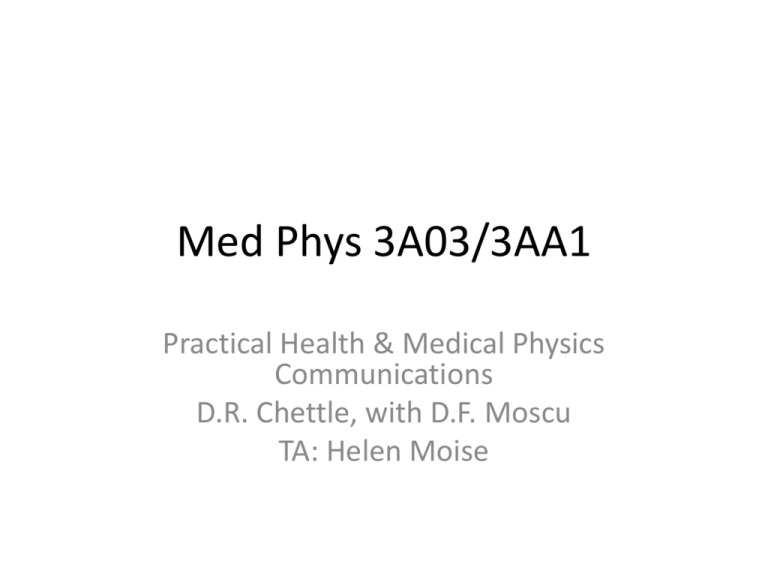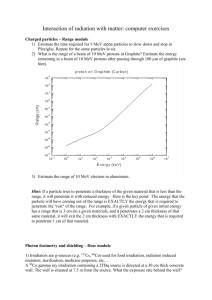Med Phys 3A03/3AA1
advertisement

Med Phys 3A03/3AA1 Practical Health & Medical Physics Communications D.R. Chettle, with D.F. Moscu TA: Helen Moise Field radiation surveys Module 2 October 15th, 13:30 – 14:20: introduction October 22nd, 13:30 – 15:20: lab, groups A1 & A2 October 29th, 13:30 – 15:20: lab groups B1 & B2 November 5th, 13:30 – 14:20: report back Field radiation surveys • What radiation fields? • What survey instruments? Field radiation surveys • γ-ray radiation field: 226Ra • • • • • t½ 1600 y 226Ra→222Rn + (4He), 5.5% to excited state, which de-excites emitting γ-ray (186 keV, 3.3%) t½ 3.82 d 222Rn→218Po + , 99.9% to ground state t½ 3.05 m 218Po→214Pb + , 99+% to ground state t½ 26.8 m 214Pb→214Bi + -, various levels, many γ-rays (352 keV, 37%) t½ 19.7 m 214Bi→214Po + -, various levels, many γ-rays (609 keV, 46%) • Balance of γ-rays depends on whether chain decay is in equilibrium, governed by t½ of daughters Equilibrium? • Nbλb = λb (1 – e-(λb – λa)t) Naλa (λb – λa) λa = ln(2)/(1600x365) λb = ln(2)/3.82 λc to λe > = λb At 0.3 day, 0.053 x equilibrium At 3 days, 0.420 x equilibrium At 30 days, 0.996 x equilibrium PGNAA of Cd • Based on thermal neutron capture and detection of prompt gamma ray emitted Reaction 113Cd(n, )114Cd Natural abundance Thermal neutron capture crosssection Elemental cross-section Prompt gamma 12.2 % 20,600 b 2500 b 559 keV – 238Pu-Be neutron source – 2000 s live time measurement – 0.8 mSv/hr skin dose rate Neutron Source for PGNAA • 238Pu-Be – – – – source (17 Ci, 4 MeV average neutron energy) Beryllium premoderator softens the high energy neutron spectrum Neutrons collimated by steel and graphite cylinders and by layers of polyethylene and steel Blocks of lead, hevimet and bismuth shield the detector Assembly encased by borated resin plates PGNAA Detection System Top view of PGNAA experimental apparatus (not to scale). • System optimized to lower the MDL of Cd in the liver and kidneys • Phantoms filled with known concentrations of Cd Field radiation surveys • Neutron radiation field – 1 • 238Pu/Be • 238Pu → 234U + + Q (= 5.593 MeV) • 4He + 9Be → 12C + 1n + Q (= 5.702 MeV) • 4He + 9Be → 12C + 1n + Eex+ Q (= 1.263 MeV) Eγ = 4.439 MeV Neutron energies up to ~10.3 MeV Neutron source At McMaster we have: • Reactor – not suitable, En > 2 MeV • 238Pu/Be source: – uses reaction 4He + 9Be – Not suitable, En > 2 MeV 12C +n • Accelerator: – Uses reaction 7Li + 1H 7Be + n – Threshold at 1.88 MeV Ep – At Ep = 2.3 MeV, En = 0.55 MeV (max) << 2 MeV Neutron Activation Source • There are three main components to the in vivo neutron activation analysis system • The Tandetron accelerator provides the source of neutrons via the 7Li(p, n)7Be reaction Irradiation/Shielding Cavity • An irradiation/shielding cavity has been designed to maximise activation of 28Al while minimising radiation dose to the subject Experimental Setup Field radiation surveys • • • • • • • Neutron radiation field – 2 Tandetron accelerator Reaction 7Li(p,n)7Be (7Li + 1H → 1n + 7Be) Q = -1.643 MeV, Ep(th) = 1.878 MeV Accelerate protons to 2.3 MeV, En = 0.575 MeV Also get 478 keV γ-ray from Li target from 7Li(p,p´)7Li reaction Field radiation surveys • Survey instrument – 1 • Ion chamber, Victoreen 451B • Measures: -particles E > 7.5 MeV; -particles E > 100 keV Photons E > 7 keV • Air ionisation chamber, 349 cm3 • Sliding shield to eliminate (most) -particles Field radiation surveys • • • • • Survey instrument – 2 Neutron detector, Ludlum 42-31H Proportional counter filled with 3He Reaction n + 3He → 3H + 1H + Q (Q = 0.764 MeV) Thermal neutron reaction, less probable at higher energies • Slow down some of the neutrons before they reach the 3He counter • 3He detector surrounded by a Cd loaded polyethylene sphere, 22.9 cm diameter Field radiation surveys • Maximum permitted dose rates Nuclear energy workers 25 Sv h-1 General public 2.5 Sv h-1 (2.5 mrem h-1/0.25 mrem h-1) Field radiation surveys • Warning notices: If dose rate exceeds 2.5 Sv-1 , unless • Controlled area then If dose rate exceeds 25 Sv-1









